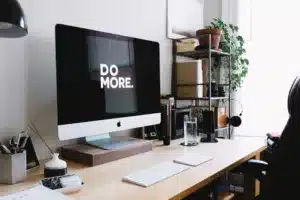No, it’s not some high-tech marketing strategy, a studio upgrade or anything huge that is going to require you take on a second mortgage. In fact, this one step is not going to cost you a cent but is worth your time invested tenfold. Yes, today we are talking about systemization.
Don’t stop reading – we know it sounds boring but setting up systems for your studio is absolutely crucial if you want to grow (which you do) and if you are ready to step up your role as the CEO of your studio. Put simply, you cannot afford to keep doing everything yourself and storing all of your studio processes and procedures in your head. The funny thing is that most – if not all – studio owners are guilty of this in one way or another. So let’s break it down into some simple steps that will show you WHY you need to get systems set up in your studio, and then HOW to go about it most effectively.
What Does It Mean To Have ‘Systems In Place’ In Your Studio?
You’ve probably heard this terminology thrown around many times in business without having a great understanding of what it means. Let’s break it down to the very basics. Firstly, setting up a ‘system’ is simply documenting the steps taken to complete a task. Here’s an example:
| How to brush your teeth Step 1/ Remove toothbrush and toothpaste from cup Step 2/ Remove cap and squeeze a small amount of toothpaste onto the toothbrush bristles Step 3/ Replace cap and place toothpaste back in cup Step 3/ Quickly run toothbrush under water to make sure the toothpaste isn’t too sticky Step 4/ Brush your teeth in a circular motion for no less than 60 seconds. Remember to include gums, molars and your tongue when brushing Step 5/ Spit out toothpaste Step 6/ Rinse mouth with water Step 7/ Return toothbrush to cup and dry your mouth with your facewasher Step 8/ Floss teeth (See system #2 for full flossing system) Step 9/ Rinse with mouthwash (See system #3 for full mouthwash system) |
This is an example of a system that you would not typically have documented at home – it’s something you do every day, that you could do on autopilot and it’s not catastrophic if you get it slightly wrong every so often, but it’s a good example to show what a system does and how it comes in helpful when it comes to the bigger picture things in home and life.
Have you ever seen a mother leave a “how to” list for the babysitter or their spouse who has never looked after the baby solo before? This is where you’ll find a thorough system in place down to the minute, guaranteed!! Likewise In your studio, your systems are the “How To…” for anything and everything that needs to be done.
Why Do We Need Systems In A Dance Studio?
The #1 reason you need to have all of your systems documented in the studio is because life happens and sometimes things go wrong. Usually it isn’t until something DOES go wrong (an unexpected illness, family emergency or time away from the business) that studio owners realise just how much is being stored in their heads that they can’t simply hand over to a trusted team member at the drop of a hat to take over when needed.
Imagine being laid up in hospital with a sudden bout of appendicitis that puts you out of action for a week. If you’re one of the studio owners we are talking about, not only are you in a huge amount of pain but you’ve also got the added stress of realising that your office manager has no idea how you have organized the recital ticket orders and payments that are being collected the next day. They also have no idea that a new parent has contacted you via Facebook to trial a new class that afternoon, or who needs to be contacted to cover your own sessions while you are away.
It’s not usually until things do go wrong that you realize what is needed, so there is no greater gift that you can give your team and yourself than to get on top of how things run in your business in case you or your right-hand-man/woman can’t be there.
But it’s not only these ‘worst-case-scenarios’ that highlight your need for systems to be set up properly in the running of your studio. Documenting your processes is guaranteed to lower your stress levels and those of your team during busy times. Once you start systemizing you will also be able to see where there are holes in what you are doing that need to be fixed, or alternative ways of doing them can be explored.
You also need to think long-term and how your system documentation is going to be a huge asset when it is time to sell your studio, and having these ready to present to potential investors will add value to your studio.
What Systems Do We Need In Place?
You need systems for absolutely everything that you and your team are doing in the business – this is an ongoing task and not something you can do in a week. The best way to plan for this is to start a sheet and list every single thing that happens in your studio daily, weekly, monthly, quarterly and annually (don’t freak out by the length of your list! It’s meant to be huge!) It may start looking something like this:
- Taking a phone enquiry
- Creating a customer invoice
- Receiving a payment
- Adding a new client to your studio software
- Updating contact information for a student
- Enrollment procedure
- Monthly newsletter process
- Unlocking the studio
- Email checking and filing
- How to prepare tax documents for accountant
- Using the sound system
- Staff leave applications
- Setting up for preschool ballet
- Marking and filing class rolls
- Scheduling classes
- Recital/concert ticketing
….and the list goes on. There will be hundreds, and some will take 5 mins to write (for example, “how to order toilet paper for studio”) while others may take a few days and involve many sub-systems (for example, “Running the recital/concert”). Once you’ve got your starting point it’s a great idea to aim to create 2 per week. You can go with one simple system and one complex system so that there is some balance in your workload.
Don’t forget – you are not the only person in your business who needs to do this! Your office manager, admin staff and teachers are also going to need to jump in and document their own roles and procedures for you to add to your master list.
How To Document Systems In Your Studio
There are hundreds of different ways that you can go about documenting the systems in your studio, and some of these things may be used in combination. It’s important that you find a way that works for you.
A simple word processing document – For this crucial step, it doesn’t get much more simple than Google Docs, which is a great way to document your systems in a live document so you can see when it was last updated, and which changes have been made. You can use Google Docs or any other word processing tool as a written document is the best backbone for system creation and maintenance in your studio. Make sure to cover each step clearly, and don’t assume any prior knowledge of the person who may be reading it eventually. For example, in your system for adding a new client to your database, ensure you provide links to the database so they can find it in case they don’t know where it is kept.
2/ Screenshots – Most of your systems will require screenshots so that you can see the steps as they are needed. There are loads of screen capture options that will allow you to take a screenshot and include annotations such as Snagit, Awesome Screenshot, or TinyTake (as shown below)
Videos – A time-effective way of creating systems is to use video or screen-recordings of how you complete certain tasks, and it is particularly helpful for lengthy or complex systems that you need to document. You can use any of the aforementioned screenshot options to screen-record what you are doing on your computer. For your system to be best documented however, it is important to transcribe the actions in the video into a written document as well. The good news? Once you have recorded the steps you can pay someone else to do the documentation for you (a current employee, contractor or virtual assistant can take on this role)
Testing – Once you have written out your 2 systems for the week, you’ll need to test them to make sure they make sense and don’t have any gaps. You can do this by swapping systems with a staff member, so they follow the instructions you have provided and vice-versa.
And that’s it – simply rinse and repeat and you’ll never look back!
If you’d love more resources on systemizing your studio and growing the business of your dreams, we’d love you to join us in the Dance Studio Owners Association!
SHARE THE LOVE
[Sassy_Social_Share]

Start filling your summercamp classes now!

Build a team that’s comfortable sharing feedback, motivated to continually improve & 100% aligned with your studio’s values & mission





